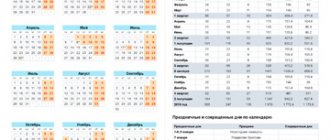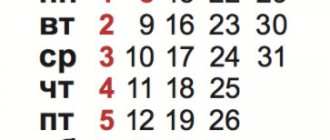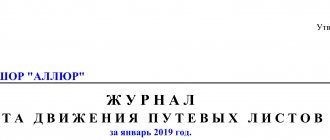To correctly calculate wages, it is necessary to take into account the hours actually worked by employees. To do this, the employer must keep a time sheet. It is a list of team members with notes about the appearances and absences of each of them, the number of hours worked, as well as summary data for 2 weeks and a month.
We suggest you figure out in accordance with what rules and in what form this document should be maintained. At the end of the article, you can download the completed timesheet for 2021 for review.
Payroll and personnel records
How to fill out a time sheet
It is permissible to fill out one general timesheet for the entire organization or for each structural unit separately. It reflects reliable information about the use of working time by employees of this enterprise. The timekeeper notes both the time actually worked and the time not worked. This could be: downtime, illness, absenteeism, business trips.
The timesheet can be maintained in two ways
There are ready-made unified forms approved by the relevant authorities:
- If the enterprise has introduced time-based wages, then forms T-13 and T-12 are used.
- If there is piecework payment, then the enterprise has the right to develop its own forms and forms for accounting and control.
Form T-12 - filled out manually.
Form T-13 - used where it is possible to automate the processing of accounting data.
The first way to keep a timesheet - general recommendations
In the T-12 form, entries are made with a ballpoint pen, carefully, without making blots, by hand. Concealer cannot be used.
Section 1 (columns 1–6) is formatted in a table.
The fourth column contains 2 lines for marking the employee’s attendance or absence. Filling Feature:
- the first line is filled in capital letters (symbols);
- the second line contains a figure indicating the number of hours worked for a certain period;
Section 2 is completed by an accountant.
This section is presented in the form of a table where the timesheet number for each employee, his salary and hours worked are entered. Based on these data, salaries are calculated. On the fourth page of the form, you enter data that will help you compile statistical reports. It is filled out according to special instructions.
Second way of conducting
In the T-13 form, some columns are already filled in automatically: department, surname and profession of the employee, timesheet number.
Accepted conventions.
The full list can be seen in form T - 12. Some main ones are presented in the table:
- Working hours Letter designation Digital code.
- Regular attendance I 01.
- Night hours N 02.
- Release on holidays and weekends RP 03.
- Recycling From 05.
- Business trip K 06.
- Vacation from 09.
- Additional leave OD 10.
- Study leave U 11.
- Shortened working hours for students on-the-job LV 12.
- Study leave at your own expense UD 13.
- Maternity leave R 14.
- Leave to care for a child up to 3 years of age 15.
- Vacation at your own expense health insurance 17.
- Sick leave B 19.
- Shortened working hours for Champions League 21.
- Absenteeism PR 24.
- Non-working days, day off at 26.
- Absence for an unknown reason NN 30.
Instructions for filling out a working time sheet in form T-13
As we have already noted, the T-13 is more frequently used in practice, so let’s start our acquaintance with it.
The form consists of a header and a table and usually fits on one sheet. The company name is included in the header. If the time sheet is compiled for a structural unit, its name must also be entered. In addition, the OKPO code, date, document number and reporting period are indicated. Next follows two sheets of tabular part.
In column 2 of the work time sheet in the T-13 form, broken down by structural divisions, the surnames and initials of all company employees, as well as their positions, are entered. The data is taken from the staffing table. Column 1 contains the serial numbers of the persons on the list, and column 3 – their personnel numbers.
Column 4 contains cells corresponding to calendar days - from the 1st to the 31st. They are placed in 2 rows: the top row is from 1 to 15, the bottom row is from 16 to 31. For each day there are 2 cells located one above the other. The code is entered at the top, and the number of hours at the bottom.
Filling out a timesheet is not always easy, because there are sometimes incomprehensible moments. Let's consider a couple of situations that cause difficulties for employers:
- Working overtime. The cells are entered using a fraction. The codes “Y/S” are written in the upper cell, and the values “8/2” are written in the lower cell. This means that on a particular day a person worked 8 hours and worked overtime for another 2 hours.
- Long absence. For example, a woman went on maternity leave. Should it be included in the timesheet? Yes, it's necessary. The list includes everyone who works in the organization on the day it is compiled. In the case of parental leave, the code “OZH” is entered, and the cell with the number of hours remains empty.
Column 5 summarizes the results for the 1st-15th day of the month: in the top cell - the number of working days, in the bottom - hours worked. Similarly, the results for the month are reflected in column 6.
Columns 7-9 reflect the data for calculating wages. Column 7 is intended to indicate the payment type code. It is needed for an accountant who will calculate salaries based on the timesheet in order to understand the type of accrual. Resolution No. 1 does not specify where exactly to get these codes, so the employer can develop his own coding. But they traditionally use the List of codes for types of income for tax purposes, approved by order of the Federal Tax Service of Russia dated September 10, 2015 No. ММВ-7-11/ [email protected]
There are not many most used codes. For example, 2000 – basic salary, excluding bonuses, 2012 – vacation pay, 2300 – sick leave, 2002 – bonuses paid not at the expense of profits (reduce the income tax base), 2003 – bonuses at the expense of profits.
Column 8 indicates the accounting account on which the costs for a specific payment are reflected. It depends on how the accountant will post this accrual. For example:
- Dt 20 Kt 70 – accrual of wages to employees engaged in production (main activity). In column 8 enter “20”;
- Dt 23 Kt 70 - accrual of salary to support service employees (for example, an accountant). “23” is entered in column 8;
- Dt 69 Kt 70 – accrual of sick leave to employees. “69” is entered in column 8.
In column 9 indicate the total number of days for 2 weeks, and in brackets - the hours that need to be paid according to the corresponding code.
If the document is filled out for a department with a small number of employees, it is very likely that the wage type code and invoice may be the same for everyone. In this case, they can be indicated once - for this, lines are left in the header of the table, above columns 7-9.
In columns 10-13 you need to duplicate all no-shows for the month. The entry occupies 2 cells horizontally. First, enter the code, and next to it - the number of days (hours) of absence from work. For example, the entry “FROM 3 (24)” will mean that during the month the employee missed 3 full working days (24 hours) due to the main vacation.
This completes filling out the time sheet. The finished form is signed by the timekeeper, the head of the organization or structural unit.
If reflecting the data in the timesheet is difficult, we recommend that you look at the sample filling at the end of the article.
Basic forms of timesheets
T-12 report card form in MS Word format.
Figure 1. Form T-12.
Figure 1 shows an example of correct time recording for that category of workers whose working hours have been legally reduced.
Thus, on the eve of public holidays, the working day is shorter than usual by one hour. All employees of organizations enjoy this right. The number seven is entered on the report card. Example. From employee Sidorov V.P. The working day is 7 hours. Before the holiday it will be 6 hours and the number six will be entered on the report card. This point must be observed to avoid recycling.
Figure 2. Form T-13.
form of report card T-13 in MS Word format.
Answer
As we understand from your question, the employee is assigned part-time working hours.
At the same time, we note that if part-time working hours are established for an employee upon hiring, then this condition must be reflected in the employment contract, as well as in the hiring order.
about a sample of filling out a time sheet by following the link.
In the employment contract, in the “Working hours” section, indicate part-time work, and also specify the working conditions (for example, “ The employee is assigned
a part-time work week. The working day is Monday
.
The start and end times of classroom classes are determined by the class schedule. The duration of work is ... hours per week
").
Indicate the employee’s salary in the employment contract in full (for a full rate), and it is necessary to indicate that the salary is calculated for the time actually worked (for example, “ The employee has a monthly salary of 17,000 rubles
.
Wages are calculated depending on the amount of time actually worked
."
Fill out the order using the unified form No. T-1, in the line “Conditions of employment, nature of work” indicate that the employee is hired on a part-time basis.
Thus, it turns out that in the time sheet, you must mark the actual time worked by the employee, taking into account the working hours established for the employee.
As a rule, only cases of deviations from the normal use of working time established by the internal labor regulations are recorded in the Timesheet (f. 0504421). In the upper half of the line, for each employee who had deviations from the normal use of working time, hours of deviations are recorded, and in the lower half - symbols of deviations.
If you keep a complete registration of appearances/no-appearances, then for days off from work such an employee must be marked with the letter designation of the day off “B”.
If we proceed from a 36-hour week, we find that at 0.6 rates an employee must work 0.6 * 36/5 = 4.32 hours a day with a five-day work week.
Features of the working time and rest time regime for teaching and other employees of educational institutions are prescribed in Order of the Ministry of Education and Science of the Russian Federation dated March 27, 2006 N 69 “On the peculiarities of the working time and rest time regime for teaching and other employees of educational institutions”
https://budget.1kadry.ru/#/document/99/901975022/?step=34.
Details in the materials of the Personnel System:
1.Answer: How to set the work schedule for a teaching worker
Legislative regulation of working hours
What documents regulate the working hours of teaching staff?
The working hours of teaching staff of educational organizations are regulated by:
Reduced working hours
How to establish reduced working hours for teaching staff
Teaching staff are provided with a reduced working time, which should not exceed 36 hours per week (Article 333 of the Labor Code of the Russian Federation, Article 47 of the Law of December 29, 2012 No. 273-FZ). Depending on the position and (or) specialty, taking into account the characteristics of their work, teaching staff may be assigned a different (less than 36 hours) duration of the shortened working week (Order of the Ministry of Education and Science of Russia dated December 22, 2014 No. 1601).
You will have no questions about the additional payment for the title of honored teacher after reading the article at the link.
Thus, a 20-hour work week is established for speech pathologists and speech therapists. The norm equal to 18 hours per week is determined for teachers of educational organizations implementing basic general education programs, including adapted ones (clause 2 of Appendix 1 to the order of the Ministry of Education and Science of Russia dated December 22, 2014 No. 1601). The specified hours norm is determined in astronomical hours and short breaks (changes) between them, as well as a dynamic pause (clause 2 of the note to Appendix 1 to the order of the Ministry of Education and Science of Russia dated December 22, 2014 No. 1601).
During working hours, teaching staff, depending on their position, include:
- educational (teaching) and educational work;
- individual work with students;
- scientific, creative and research activities;
- other types of teaching work provided for by job responsibilities and (or) individual plan;
- methodological, preparatory, organizational, diagnostic, monitoring work;
- work provided for by plans for educational, physical education, sports, creative and other events carried out with students.
Who has the right to fill out the timesheet
It can be filled out by any employee designated by the relevant order. For example:
- Timekeeper - if there is a position in the staffing table. Filling out the timesheet will be his direct responsibility.
- Another staff member. For him, keeping a time sheet is one of his main responsibilities. Therefore, it, among others, is prescribed either in the employment contract or in its job description.
- HR inspector.
- Any other employee assigned these duties.
How to record time worked
For any length of the working day, regardless of the established modes, working time can be reflected in the accounting table in two ways:
- method of continuous registration of attendance and absence from work;
- by recording only deviations (no-shows, overtime, etc.).
If the length of the working day (shift) is unchanged, only deviations can be recorded, since the terms of the employment contract or internal labor regulations determine the number of working hours for each day of work.
In the case where the number of hours worked on different days (shifts) may be different, for example, when recording the total time worked, the continuous registration method should be used. This will allow, after the end of the accounting period, to identify possible overtime work, as well as to adjust the further involvement of the employee in work within the limits of the norm for the length of time worked established for this category.
Notes on the working time sheet about the reasons for absence from work, working part-time or beyond its normal duration at the initiative of the employee or employer, shortened working hours, etc. are made on the basis of properly executed documents (certificate of incapacity for work, certificate of performance of state or public duties, a written warning about downtime, an application for part-time work, the employee’s written consent to work overtime in cases established by law, etc.).
Typical errors found in report cards
Situation 1.
The employee goes on another vacation. We remember that holiday weekends are included in the number of calendar days and not (days off). You can put a symbol in the form of “OT”, or a number – “09”.
Attention! If there is a non-working holiday(s) during the vacation period, then it(es) is not considered a calendar day. In the report card, he/she is indicated as a day off: the symbol “B” or the number “26” is used.
Example. Employee Rychkov V.V. takes leave for 14 calendar days from 4.06 to 18.06. Please note that June 12 is a public holiday. The timesheet will be filled out as shown in Figure 3.
Situation 2.
The employee, while on vacation from June 1 to June 15, fell ill. He informs the enterprise administration about his illness from June 4 to June 9 (6 days). There is a sick leave certificate. His vacation will last for 6 days, which he did not use due to illness.
In this example, the employee used three calendar days of vacation, then became ill and had 11 more calendar days left. He is due to return to work on June 22.
Special cases of registering a business trip on a timesheet
When determining the duration of business trips, vacations or other moments, you can use the following recommendations:
- The business trip is marked with the letter “K”. The duration of the business trip is noted in the relevant order.
- If, while an employee is on a business trip, there is a day off or a holiday, then he will be paid at a double rate. On the report card it is written o, not the output “B”.
How to properly mark a business trip if an employee is on sick leave? Case from practice.
For production reasons, the enterprise administration decides to call him and send him on a business trip even before the “closure” of his sick leave. In this situation, the actions of the administration and the employee are a violation of labor laws.
The timekeeper actually fills out the timesheet like this:
- The fact of absence (illness) before the start of the business trip is indicated with the symbol “B”.
- The symbol “K” marks the days of the business trip.
- After returning from it, we put either “B” (if the sick leave is not yet closed), or “I” - if the sick leave is closed.
But if you fill out the report card this way, there may be consequences.
Risk 1. If the records look like this: “B” (illness), “K” (business trip), after it – “I” (attendance to work), without covering sick leave, then, for the number of days the employee is on a business trip, the Social Insurance Fund Russia does not recognize this part of sickness benefits.
Risk 2. If the report card is filled out like this: “B” (illness), “K” (business trip), and after that – the continuation of illness “B” - then the FSS will refuse to compensate the entire amount of the benefit.
It must be remembered that the benefit is paid for illness. If an employee returns to work, it means he is able to work.
Blitz - tips and recommendations from work experience
- The timekeeper fills out the form only if there is a reason: an order or written instruction, or other documents.
- In the unified form, all the details provided for in it are entered and all lines are filled in. Unfilled lines must be crossed out.
- Two timesheets are drawn up per month, for the first half and the second, if salaries are calculated twice a month.
- Errors made when filling out the report card are corrected according to strictly established rules: first, incorrect entries are crossed out with one line, and the correct ones are written above them. The employee filling out the time sheet puts his signature and all persons responsible for this document sign.
- If the timekeeper does not yet know why the employee did not show up to work, then the timesheet will be marked as NN. When supporting documents are provided, the report card is adjusted.
Sample order to appoint a person in charge
The order is drawn up in free form, it includes a preamble and an administrative part. The preamble states the basis and/or purpose of the order. In this case, you can, for example, write “For the purpose of recording working time,” “Guided by Article 91 of the Labor Code of the Russian Federation,” or include both of these wordings.
The administrative part indicates the responsible person. In a large organization, it is advisable to appoint several people and assign a specific structural unit to each. The director can also indicate the person responsible for executing the order, or assign control to himself. The order ends with the signature of the manager, as well as the responsible persons - they must be familiar with it.
Who needs a report card and why?
It, as a primary document, is needed:
- Accounting. Based on this document, the employee’s salary is calculated. The report card confirms the fact that the employee is fulfilling his duties.
- Tax Inspectorate. The correctness of calculation or withholding of taxes from salaries is checked. A reconciliation of the hours worked, noted in the timesheet, is made with the data on salary payments.
- The report card may be required by specialists from the Russian Social Insurance Fund. The correctness of payment of benefits from the fund is checked.
- Bodies of the Federal Migration Service. When checking employers who hire foreign citizens as employees.
- Specialists of the Labor Inspectorate. The inspector, checking the report card, will be able to establish the fact of violation of labor laws. Thus, when checking compliance with the overtime hours norm, a fine is provided for detected deviations. If the terms of reference are violated again, the manager may be dismissed from his position.
- The report card can be used as evidence in court if a labor dispute arises. For example, the legality of dismissing an employee for absenteeism.
- Statistical authorities. According to the report card, a number of reports are compiled. For example, a report on form P-4.
Time sheet: about the obligation to maintain
The obligation to take into account the time worked by employees is defined in Article 91 of the Labor Code of the Russian Federation. It applies to all employers, regardless of the form of business organization and its size. Microenterprises that have refused to draw up internal regulations on the basis of the provisions of Article 309.2 must also keep a timesheet. The reason is that the time sheet is not a labor law document, since it does not establish any standards. This is the primary accounting document, and it is mandatory for everyone.
It does not matter what wage system the employer has adopted – time-based or piece-rate. Maintaining employee time sheets is mandatory in any case. After all, recording hours worked is necessary not only for calculating wages, but also for monitoring the implementation of the work and rest regime.
The absence of a work time sheet may result in a fine under Part 1 of Article 5.27 of the Code of Administrative Offenses, as it is a violation of labor legislation.








